 | Water Module |
|
|

Field Preparation
|
Rivers and Streams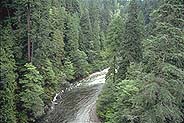 Streams in a watershed are grouped by numbers based on size:
Streams in a watershed are grouped by numbers based on size:
Note: It takes 2 streams of the same order, coming together, to make the next larger order (i.e. Two 1st order streams make a 2nd order stream. A 2nd and 1st order is still a 2nd order.)
Stream FlowFlow is the volume of water moving past a point in a unit of time. Two components make up flow: the volume or amount of water in the stream, and the velocity or speed of the water moving past a given point. How Flow Affects a StreamThe concentrations of pollutants and natural substances are influenced by stream flow. In larger volumes of faster moving water, a pollutant will be more diluted and flush out more quickly. Flow also affects the amount of oxygen dissolved in the water, as well as the temperature of the water. Higher volumes of faster moving waters, especially "white water", helps churn atmospheric oxygen into the water. Turbulence is one of the main "mixers" of oxygen in a stream. The steepness (gradient) makes a difference on the energy, or speed, which the water flows and mixes with air. Smaller volumes of slower moving water can heat up more dramatically in the heat of the summer sun.
The amount of sediment and debris a stream can carry also depends on flow. High volume, sediment-bearing flows have greater erosional energy, while smaller and slower flows allow sediment to be deposited. Because of its effect on the chemical and physical nature of streams, flow helps determine what plants and animals live in a stream. For instance, salmon require high concentrations of dissolved oxygen, low water temperatures, gravel for spawning and quiet pools for the young fry. Carp and catfish, on the other hand, will survive quite nicely in water with much lower oxygen levels. Aquatic insects have similar physical and chemical requirements. Suction disks and silk strands enable them to attach to rocks while using ingenious feeding tools like nets and fans to capture particles from flowing water. They also have streamlined and flattened body shapes which minimize their resistance to flowing water. Insects adapt to specific flow patterns. If these change, they will probably suffer. Factors Affecting Volume of FlowThe volume of stream flow is determined by many factors. Precipitation is generally the key factor, as it usually provides the primary source of water. After a rainstorm, stream flow follows a predictable pattern in which it rises sharply, and then falls usually gradually in the hours or days following the storm. Seasonal variation in precipitation changes the timing and quantity of runoff to streams. Usually streams have predictable periods of maximum and minimum flows that coincide with wet and dry seasons. Vegetation also affects the volume of stream flow. Vegetation absorbs water, releasing it to the atmosphere through evapotranspiration. It also increases the water storage capacity of soil, helping to conserve moisture in dry times. The habits of some wildlife may increase the water storage capacity of the soil. Moles, shrews and other burrowing animals create tunnels that catch runoff and prevent flooding. Springs, lakes, adjacent wetlands, and tributaries also affect the volume of stream flow. While each source may contribute only a small portion of the total flow in a stream, their contributions can be crucial during dry seasons. Factors Affecting Velocity of Flow The velocity of flow in the stream channel is affected by a variety of factors. Gradient is key, as water moves faster in steeper areas. Resistance is another important factor. Velocity is slower in areas of high resistance. Resistance is determined by the nature of the bottom substrate, channel shape, woody debris such as logs and root wads, and stream habitats such as riffles and pools.
The velocity of flow in the stream channel is affected by a variety of factors. Gradient is key, as water moves faster in steeper areas. Resistance is another important factor. Velocity is slower in areas of high resistance. Resistance is determined by the nature of the bottom substrate, channel shape, woody debris such as logs and root wads, and stream habitats such as riffles and pools.
Stream flow can be altered by human activities both in the surrounding watershed and directly in the stream. When naturally vegetated areas and wetlands are converted into bare soil and impervious surfaces, such as roots and pavement, the volume of stream flow will increase sharply during wet seasons. In dry times, however, the opposite problem occurs. Without natural vegetation or wetlands, much of the water storage capacity of a watershed is lost. In dry times, stream flow may be severely reduced or even non-existent. Channelizing a stream and removing woody debris and other large objects can increase the velocity of flow. In the past, it was a common practice to straighten and "clean up" streams, in order to prevent flooding by allowing the water to move quickly downstream.
Adult fish swim at different speeds; cruising, sustained and burst. For example, Chinook salmon can cruise from 0 - 8.6 ft/sec and burst up to 21.8 ft/sec. On the other hand, Whitefish can cruise from 0 - 1.3 ft/sec and burst up to 8.6 ft/sec. |

Sitemap | Contact Us |
|
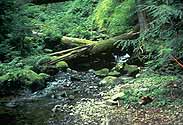 Streamside vegetation (riparian zone) is an important component of
the
Streamside vegetation (riparian zone) is an important component of
the 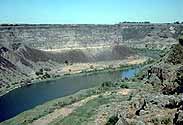 In arid and semi-arid conditions, riparian vegetation is very important. Research has shown that these zones are extremely fragile, and are an integral part to the stream ecosystem.
In arid and semi-arid conditions, riparian vegetation is very important. Research has shown that these zones are extremely fragile, and are an integral part to the stream ecosystem.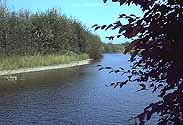
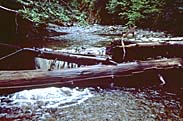 Stream flow determines the nature of physical features, such as the types of habitats present, the shape of the channel, and the composition of the stream bottom.
Stream flow determines the nature of physical features, such as the types of habitats present, the shape of the channel, and the composition of the stream bottom.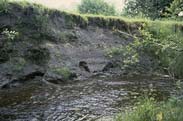 More recently, we've realized that these practices may actually create worse problems than they solve. Besides their serious consequences for aquatic and riparian life, they often cause erosion and flooding problems in downstream locations. A straight "clean" stream channel has much less ability to absorb the force and volume of flow, but a meandering (wavy) stream has more ability to absorb the force and volume of flow.
More recently, we've realized that these practices may actually create worse problems than they solve. Besides their serious consequences for aquatic and riparian life, they often cause erosion and flooding problems in downstream locations. A straight "clean" stream channel has much less ability to absorb the force and volume of flow, but a meandering (wavy) stream has more ability to absorb the force and volume of flow. Dams or diversions change the flow of water in stream channels directly by slowing it, detaining it, or re-routing it. Some aquatic organisms have timed their life cycles to natural flowing rivers. Some can adapt to the new conditions caused by dams, such as water flows changing when more electrical power is needed. Many organisms have not been able to adapt.
Dams or diversions change the flow of water in stream channels directly by slowing it, detaining it, or re-routing it. Some aquatic organisms have timed their life cycles to natural flowing rivers. Some can adapt to the new conditions caused by dams, such as water flows changing when more electrical power is needed. Many organisms have not been able to adapt.